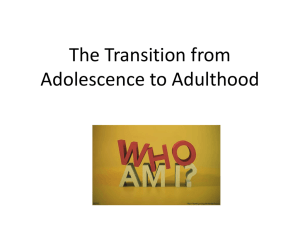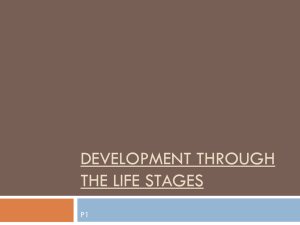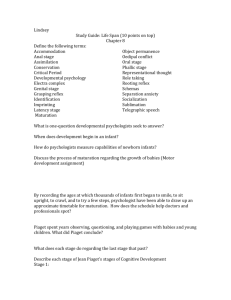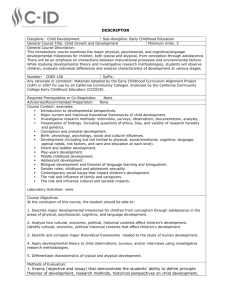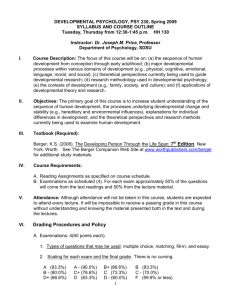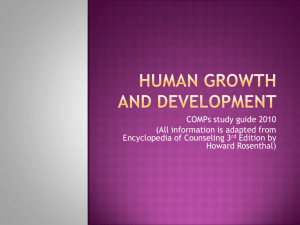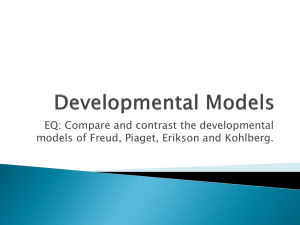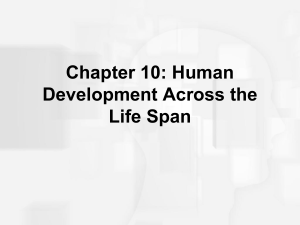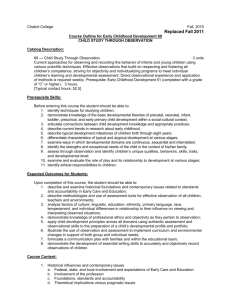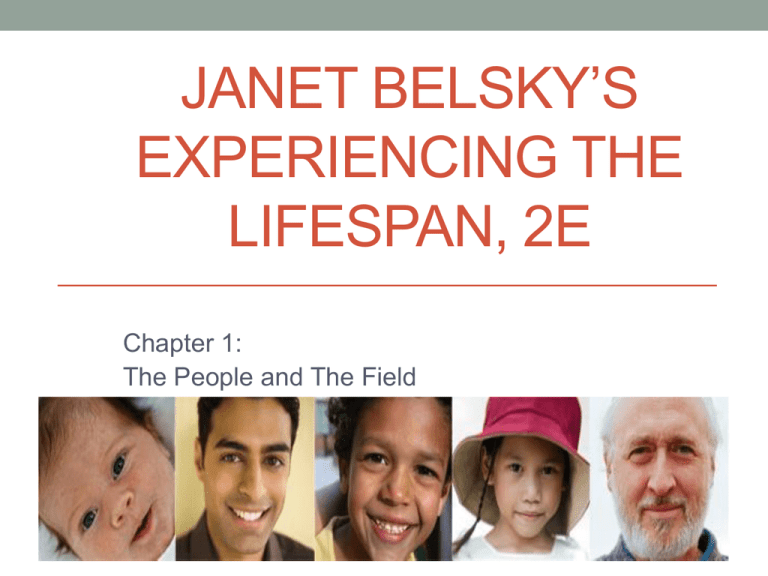
JANET BELSKY’S
EXPERIENCING THE
LIFESPAN, 2E
Chapter 1:
The People and The Field
What We Are Studying?
• Developmental Psychology
• Also known as lifespan development,
________________________________________________
________________________________________________
______________________________________________
• Includes physical, cognitive, socio-emotional changes during
the life span
• This field includes the study of:
• Infant and Child Development
• Adult Development
• Gerontology
• Exploration of predictable milestones in development
• Individual Differences
• Life Transitions and Practices
Questions to Ask Yourselves
• What are some of the changes that occur over our lives??
• How have you changed?
• Has your thinking changed?
• Are your relationships different?
• Do you feel different?
Life Changes
Periods of Development
• Prenatal Period
• __________________________________________________
_________________________________________________
• Infancy
• Includes the developmental period from birth to about age 2
• Childhood
• Early- preschool years ages 3 through 5
• Middle- __________________________
• Adolescence
• Early- ages 12 through14
• Middle- ages 15 through 19
Periods of Development
• Adulthood
• Early- 20’s and 30’s
• Issues include achieving intimacy, career choices,
marriage, and potential parenthood.
• Middle-40’s and 50’s
• Issues include launching children, changing physical
performance, increased freedom, and increased career
success
• Late-60’s and Over
• ______________________________________________
______________________________________________
Changing Perceptions of Childhood
• Historical Background
• Mortality rates high;
poverty
• Childhood not perceived
as a special life stage
• Abusive treatment
common
• Children assume
_____________________
_____________________
• Norms: child labor; child
abandonment among poor
Changing Perceptions of Childhood
• Modern view, late 19th Century: kinder, gentler view of
children
• Childhood protected, dependent life stage
• Universal education: primary school mandatory
• Adolescence: identified by G. Stanley Hall in early 20th
Century
• Stage of “_____________” between childhood and adulthood
• In 1930s, High school attendance became mandatory (Great
Depression and President Franklin Roosevelt)
• Emerging Adulthood:
• Age 18 to late 20s
• Time for personal exploration
Changing Perceptions of Later Life:
Adulthood and Old Age
• Life Expectancy
• Before 20th century medical
advances, average life
expectancy was low
• Today, twentieth-century life
expectancy revolution!
• Infectious diseases wiped out
• Chronic diseases (heart
disease, cancer, etc.) today
• New Stages
• Young-old (60s, 70s)
• ____________ (80s and beyond)
Theories of Development
• _______________
• Any perspective which attempts to explain individual
behavior
• Allows us to predict behavior
• Presents ideas for interventions to improve behavior
• Nature/Nurture
• Are we shaped by biological/genetic forces or is the
environment more influential?
Theories of Development
• Psychoanalytic Theory
• Freud
• Erickson
• Bolby
• Learning Theory (Behaviorism)
• Skinner
• Watson
• Bandura
• Humanistic Theory
• Maslow
• Rogers
• Cognitive Theory
• Piaget
Do we need to know names?
• And theories?
• And Faces? And that’s it!
Freud
Erickson
Watson
Skinner
Bandura
Piaget
Maslow
Rogers
Evolutionary Psychology: Nature
• Evolutionary psychologists focus on
________________________
• Inborn, species-specific behaviors influence human development
• Speculate about the genetic roots of human behaviors
• Survival of the fittest!
Behavioral Genetics: Nature
• Field devoted to scientifically
determining the role that hereditary
forces play in individual differences
in behavior
• Twin Studies (identical and
fraternal)
• Adoption Studies
• Twin/Adoption Studies
• Heritability- 1 (totally genetic) to 0
(no genetic contribution)
• Statistic to summarize the extent to
which a given behavior is shaped by
genetics
Nature and Nurture Combined
• Consider both nature and nurture
when studying human
development!
• _____________ Forces
• Inborn talents and temperamental
tendencies naturally evoke certain
responses from others.
• Bidirectional forces in relationships
• Active Forces
• We actively select our environments
based on our genetic tendencies.
• Person-Environment Fit crucial to
flourishing in life!
Person-Environment Fit
• Basic goal of developmental science is to foster the
correct person-environment fit
• The real impact of the “nature” revolution is to allow us to
intervene to change the environment in order to enhance
one’s quality of life.
Age-Linked Theories: Piaget
• Cognitive-Developmental
Theory
• Qualitatively different stages exist in
the way thinking develops (different
age groups conceptualize the world
in completely different ways).
• Schemas (cognitive structures)
• Assimilation, Accommodation
• Studies focused on children
Cognitive Development: Piaget
• Tried to understand the unique qualities of
childhood cognition by entering children’s mental
framework, setting up tests, watching children’s
actions, and listening to them speak.
• Believed that we grow mentally through
assimilation, fitting information from the outside
world into our “schemas” (or current mental
capacities), and accommodation, enlarging our
capacities to fit in this “data” from the world.
A Preview of Piaget’s Stages
Personality Development
______________________________
Stage
Oral
(0-18 months)
Anal
(18-36 months)
Phallic
(3-6 years)
Focus
Pleasure centers on the mouth–
sucking, biting, chewing
Pleasure focuses on bowel and bladder
elimination; coping with demands for
control
Pleasure zone is the genitals; coping with
incestuous sexual feelings
Latency
(6 to puberty)
Dormant sexual feelings
Genital
(puberty on)
Maturation of sexual interests
Psychosocial Development:
Erikson
Considered
“___________________________”
Believed we continue to develop
throughout life
Exception to Freud’s idea that
development ends in adolescence
Identified core developmental tasks,
or psychosocial tasks, for each of
eight stages from infancy to old age
Believed that we need to master the
task of each previous stage in order
to progress to the next.
A Preview of Erikson’s Stages
Research Methods
• Two standard research strategies:
• Correlations
• Relate two or more variables as they naturally occur
• Correlation does not mean causation!
• _____________________
• Randomly assign individuals to groups
• Give each group a different treatment
• Determine if intervention produced a predicted effect
• Experiments can determine cause!
Cross-Sectional and Longitudinal Studies:
How do we change with age?
• Cross-Sectional
• Testing and comparing different age groups
• Gives differences between age groups
• Does not tell us the changes that occur with age
• ______________
• Test at intervals – one group over many years
Note: It’s “all statistics.” These methods are valuable,
not because they apply to everyone—but because
they allow us to make educated guesses about
human life!
Quantitative and Qualitative Research
• Quantitative
• The typical research mode in developmental science
using groups and statistical analyses to make general
predictions about behavior
• _______________
Scientist not interested in numerical comparisons
Studying through observation and interviews the life of a
single person, or observing a single individual in depth


